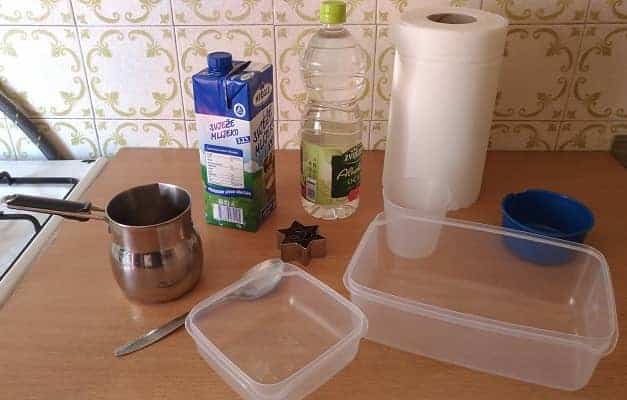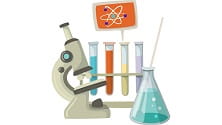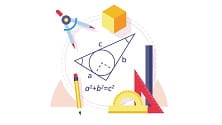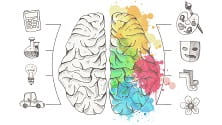Wouldn’t it be fun to make your own toys? But that sounds complicated…Well, it doesn’t have to be! All that you need is some milk, some vinegar and the molds for sculpting. We will show you how to make homemade plastic with these ingredients. Open the factory!
Article Contents
1. What is Plastic2. Plastic from Milk and Vinegar Explanation
3. Environmental impact of plastic and bioplastic
4. Materials needed for Homemade Plastic
5. Instructions for Milk and Vinegar Plastic
6. What will you develop and learn?
What is Plastic
Plastic is durable, washable material, that’s why it’s frequently used for making toys. Plastic can consist of synthetic or semi-synthetic organic compounds. Those compounds are malleable and can be molded into solid objects. There is another term for that – plasticity. That’s the property of the material that can be formed or modified into a new, permanent shape. You probably heard that our brain is plastic or has plasticity – that’s because it can change based on our experiences.
Plastic is usually synthetic and most commonly made from petrochemicals. But there are other materials for making plastic that is renewable and we can get them from corn, cotton, milk and many other plants.
Plastic is widely used due to the versatility it possesses. Low cost, ease of manufacture and imperviousness to water are just some of the characteristics that make plastic so popular. Today, we find plastic used in things that range from paperclips to space stations that orbit the earth.
The first ever produced synthetic plastic was Bakelite. It was invented in 1907. by Leo Baekeland who first used a term plastic.
The downside of plastic is that its widespread use in the early 20th century created a huge amount of trash due to the slow decomposition of the plastic large molecules. So today there is a lot of effort put in solving that problem, mainly through recycling.
But there are other ways to get plastic, for example from milk! In the first half of 19. century this method was widely used in making various decorative objects.
Plastic from Milk and Vinegar Explanation
Milk is a colloid (a mixture in which one substance of microscopically dispersed insoluble particles is suspended throughout another substance). Milk consists of water and minerals that include fat, lactose, calcium and vitamins. Two types of proteins are present in milk: around 80% of the protein is casein and the rest is whey protein.
Milk is negatively charged in its natural form. Because casein makes must of the proteins in milk, he is also negatively charged and dispersed as small micelles in the colloid. Usually, those protein molecules are folded up. When the vinegar is added to milk, the positive ions in it neutralize the negative casein micelles, they start to unfold and rearrange into long polymer chains. Casein micelles are no longer able to stay dispersed and coagulate to form a solid.
These polymer chains do not dissolve in water and can be molded in different shapes, in other words, they form organic plastic (bioplastic). The plastic produced from casein is biodegradable, edible and sustainable but today it costs more to produce so it’s usage is not that widespread.
Environmental impact of plastic and bioplastic
As already mentioned, most of today’s plastic is made from fossil fuels. On the other hand, organic plastic, or bioplastic, is mostly made from starch, cellulose, sugar, wood, and biomass. Since all of those are renewable resources, it makes it a more sustainable production activity than conventional plastic that is made from non-renewable fossil fuels.
But is the bioplastic better for the environment is still a highly debatable topic. We know today that bioplastic does significantly reduce emissions of greenhouse gasses and saves non-renewable energy consumption. But with that said, it also has some negative effects on our environment:
- Eutrophication – when water becomes overly enriched with nutrients and minerals and that results in excessive growth of algae. This process often results in oxygen depletion of the water) and
- Acidification – reduction of the waters pH value due to the more production of carbon dioxide (CO2). This can have a major negative impact on many water lifeforms.
In any case, we should strive to use plastic responsibly. Don’t create more trash, repurpose or recycle stuff. And now on to the experiment!
Materials needed for Homemade Plastic

- Milk (300 mL or more, with higher fat content)
- Vinegar (2 spoons)
- Kettle
- Colander
- Spoon
- Bowl to mix it
- Paper towel
- Molds
Instructions for Milk and Vinegar Plastic
You can check the video at the start of the article for how to make a homemade plastic, or continue reading instructions below.
- Heat the milk on the stove or in the microwave to at least 70℃ (158℉ ). We had the most success with fresh milk with 3.2% milk fat.
- Pour the hot milk into the bowl and add 2 spoons of vinegar to it. Mix vigorously for a minute or two, you should see clumps forming.
- Drain the mixture so you are working only with the solid part
- Use the paper towels (4-5) to drain that mass of any leftover water. Knead that mass with your hands and shape it into the ball
- Use the mold to make desired shapes or just shape it freestyle and leave it to dry 48h
- After that time, your sculpture got hardened and it’s done! Now you can decorate it as you wish markers or art colors
If you liked this activity, you should also check out how to make Homemade Playdough, and for more similar activities you can try and make your own rocket or try using chemistry creating some sweet treats with homemade sugar crystals. Or if you’re more into organic magic, be sure to check how to make a potato battery.
What will you develop and learn?
- Chemistry principles
- Fine motor skills
- Creativity
- Working memory
If you’re searching for some great STEM Activities for Kids and Child development tips, you’re in the right place! Check the Categories below to find the right activity for you.

STEM Science
Videos, guides and explanations about STEM Science in a step-by-step way with materials you probably already have at your home. Find new Science ideas.
Read more
STEM Technology
Videos, guides and explanations about STEM Technology in a step-by-step way with materials you probably already have at your home. Find new Technology ideas.
Read more
STEM Engineering
Videos, guides and explanations about STEM Engineering in a step-by-step way with materials you probably already have at your home. New Engineering ideas!
Read more
STEM Math
Videos, guides and explanations about STEM Math in a step-by-step way with materials you probably already have at your home. Find new Mathematics ideas.
Read more
Psychology
Find out all about development psychology topics that you always wanted to know. Here are articles from child psychology and development psychology overall.
Read more
First year of Child’s Life
Following a Child’s development every month from its birth. Personal experiences and tips on how to cope with challenges that you will face in parenting.
Read more


2 thoughts on “How to make Homemade Plastic with Milk and Vinegar”